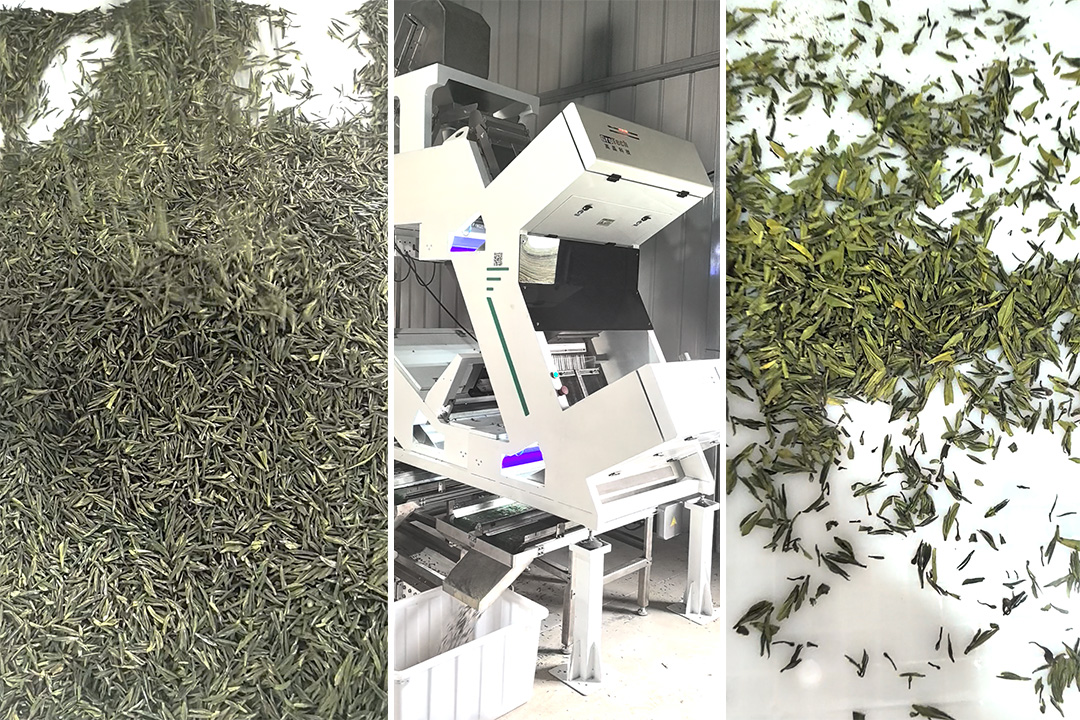ด้วยความต้องการผลิตภัณฑ์ชาพรีเมียมในตลาดที่เพิ่มมากขึ้น กระบวนการคัดแยกในการผลิตชาจึงได้ผ่านการปฏิวัติทางเทคโนโลยี เนื่องจากเป็นขั้นตอนการควบคุมคุณภาพที่สำคัญ ความแม่นยำในการคัดแยกสีจึงกำหนดมาตรฐานผลิตภัณฑ์ขั้นสุดท้ายโดยตรงAIเครื่องคัดแยกสีชาซึ่งมีประสิทธิภาพและความแม่นยำสูงจึงกลายเป็นสิ่งที่ขาดไม่ได้ในการแปรรูปชาในปัจจุบัน

1. ฟังก์ชั่นหลักและข้อเสนอคุณค่า
เครื่องคัดแยกสีชาจะคัดแยกวัสดุที่มีตำหนิออกจากชาจำนวนมาก โดยหลักๆ แล้ว ได้แก่ อนุภาคแปลกปลอม ใบชาเหลือง ใบชาที่ได้รับความเสียหายจากแมลง และความผิดปกติของสี ด้วยการตรวจจับด้วยแสงที่มีความแม่นยำสูง อุปกรณ์นี้จึงรับประกันความสอดคล้องตามคุณภาพอย่างเข้มงวด ช่วยเพิ่มทั้งความน่าดึงดูดทางสายตาและรสชาติของผลิตภัณฑ์ชา ขณะเดียวกันก็เสริมสร้างความสามารถในการแข่งขันในตลาด
2. เทคโนโลยีขั้นสูง: ระบบอัตโนมัติถูกกำหนดใหม่
ระบบที่ทันสมัยใช้เทคโนโลยีการจดจำด้วยแสงขั้นสูง โดยใช้กล้องความเร็วสูงในการสแกนใบชาด้วยความละเอียดระดับจุลภาค เมื่อผสานเข้ากับกลไกการคัดแยกการสั่นสะเทือนที่ขับเคลื่อนด้วย AI ระบบดังกล่าวสามารถผลิตงานได้เกินวิธีการแบบใช้มือแบบเดิมถึง 20-30 เท่า ระบบอัตโนมัตินี้ไม่เพียงแต่ลดต้นทุนแรงงานได้ 60-80% แต่ยังขจัดข้อผิดพลาดของมนุษย์ในการตัดสินคุณภาพอีกด้วย
3. กลไกการปรับปรุงคุณภาพ
ตัวเรียงลำดับAI การวิเคราะห์ช่วยให้มั่นใจได้ถึงความสม่ำเสมอของสีในขณะที่ขจัดสิ่งเจือปนขนาดเล็กกว่า 0.5 มม. ที่สายตาของมนุษย์ไม่สามารถตรวจจับได้ สำหรับชาพิเศษ เช่น ชาเขียวพรีเมียมและชาอู่หลงพันธุ์ที่ต้องมีการจัดระดับสีอย่างเข้มงวด อุปกรณ์ดังกล่าวให้ความแม่นยำในการคัดแยกตามมาตรฐาน ISO ที่มากกว่า 999-
4. พลวัตของตลาดและแนวโน้มนวัตกรรม
ความต้องการทั่วโลกกำลังเพิ่มขึ้นในภูมิภาคการผลิตหลัก โดยตลาดเครื่องคัดแยกสีของจีนเติบโตที่อัตรา CAGR 12.4% (2022-2030) ระบบรุ่นต่อไปกำลังพัฒนาไปไกลเกินกว่าการแยกสีเพื่อรวมการจดจำรูปร่าง 3 มิติและการถ่ายภาพแบบไฮเปอร์สเปกตรัม ซึ่งช่วยให้สามารถควบคุมคุณภาพได้อย่างครอบคลุมผ่านอัลกอริทึมการเรียนรู้ของเครื่องจักร
5. ผลกระทบเชิงกลยุทธ์
เครื่องคัดแยกสีชาเป็นเทคโนโลยีที่เปลี่ยนโฉมหน้าการแข่งขัน โดยมอบข้อได้เปรียบในการแข่งขันสองประการ ได้แก่ การยกระดับคุณภาพของผลิตภัณฑ์เพื่อตอบสนองความต้องการของตลาดระดับพรีเมียม ขณะเดียวกันก็เพิ่มประสิทธิภาพต้นทุนการผลิต โดยที่โซลูชันการคัดแยกอัจฉริยะกำลังกลายมาเป็นมาตรฐานของอุตสาหกรรม เทคโนโลยีนี้จะยังคงขับเคลื่อนการสร้างมาตรฐานในห่วงโซ่อุปทานชาทั่วโลกต่อไป